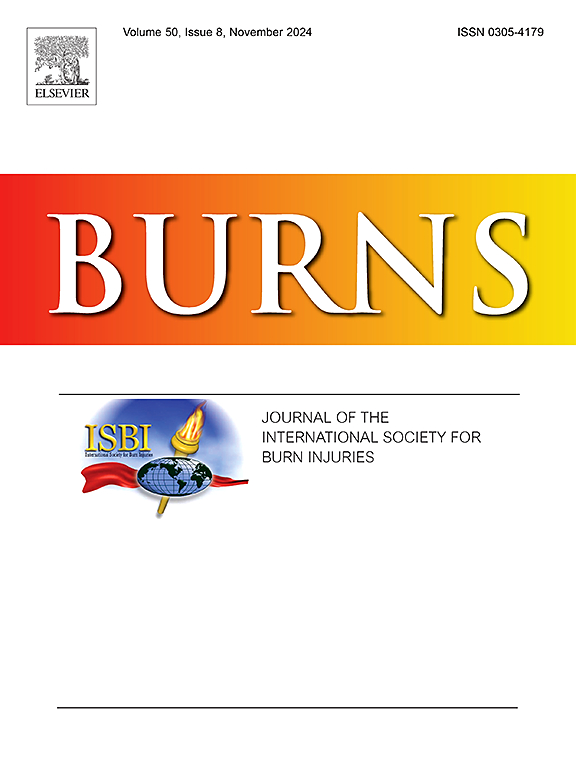静电纺丝技术治疗小儿烧伤的安全性和可行性:来自回顾性队列研究的见解
IF 2.9
3区 医学
Q2 CRITICAL CARE MEDICINE
引用次数: 0
摘要
烧伤是儿童常见的一种损伤,在换药和清创过程中采用各种疼痛管理策略和镇静治疗。静电纺丝敷料技术是一种很有前途的高级伤口护理方法,有可能改善愈合效果并减少并发症。本回顾性研究评估了静电纺丝技术在小儿烧伤患者中的安全性和可行性。材料和方法本回顾性队列研究纳入了2022年7月至2023年9月期间接受部分厚度烧伤治疗的儿科患者。18名烧伤患者使用静电纺丝技术包扎,38名接受标准治疗。该研究还比较了手术镇静的次数、阿片类药物的剂量、非阿片类镇痛治疗的持续时间,以及烧伤部位加深和烧伤部位感染的发生率。结果静电纺丝敷料在镇静治疗、镇痛和烧伤部位感染方面与标准护理相当。此外,在需要转移到专门烧伤中心或父母拒绝治疗的情况下,静电纺丝敷料和标准护理相似。结论静电纺丝敷料技术在儿童烧伤小队列治疗中与标准治疗相比具有非劣效性。需要更大规模的前瞻性随机对照试验来证实这些发现,并评估其长期效益和成本效益。本文章由计算机程序翻译,如有差异,请以英文原文为准。
Safety and feasibility of electrospinning technology for pediatric burns: Insights from a retrospective cohort study
Introduction
Burns are a common injury in children, and they are treated with various pain management strategies and procedural sedation during dressing changes and debridement. Electrospinning dressing technology is a promising approach for advanced wound care, potentially improving healing outcomes and reducing complications. This retrospective study assessed the safety and feasibility of using electrospinning technology in pediatric burn patients.
Materials and methods
This retrospective cohort study included pediatric patients with partial-thickness burns treated between July 2022 and September 2023. Eighteen patients with burns were dressed using electrospinning technology, compared to 38 receiving standard care. The study also compared the number of procedural sedations, doses of opiates, and duration of non-opiate analgesic treatments, as well as the incidence of burn site deepening and burn site infections.
Results
The electrospinning dressing yielded patient outcomes comparable to standard care regarding sedation treatments, analgesics, and burn site infections. Additionally, the electrospinning dressing and standard care were similar in cases that required transfer to a specialised burn center or parents refusing treatment.
Conclusion
Electrospinning dressing technology showed non-inferiority to standard care in this small cohort of pediatric burns. Larger, prospective, randomized controlled trials are needed to confirm these findings and assess their long-term benefits and cost-effectiveness.
求助全文
通过发布文献求助,成功后即可免费获取论文全文。
去求助
来源期刊

Burns
医学-皮肤病学
CiteScore
4.50
自引率
18.50%
发文量
304
审稿时长
72 days
期刊介绍:
Burns aims to foster the exchange of information among all engaged in preventing and treating the effects of burns. The journal focuses on clinical, scientific and social aspects of these injuries and covers the prevention of the injury, the epidemiology of such injuries and all aspects of treatment including development of new techniques and technologies and verification of existing ones. Regular features include clinical and scientific papers, state of the art reviews and descriptions of burn-care in practice.
Topics covered by Burns include: the effects of smoke on man and animals, their tissues and cells; the responses to and treatment of patients and animals with chemical injuries to the skin; the biological and clinical effects of cold injuries; surgical techniques which are, or may be relevant to the treatment of burned patients during the acute or reconstructive phase following injury; well controlled laboratory studies of the effectiveness of anti-microbial agents on infection and new materials on scarring and healing; inflammatory responses to injury, effectiveness of related agents and other compounds used to modify the physiological and cellular responses to the injury; experimental studies of burns and the outcome of burn wound healing; regenerative medicine concerning the skin.
 求助内容:
求助内容: 应助结果提醒方式:
应助结果提醒方式:


